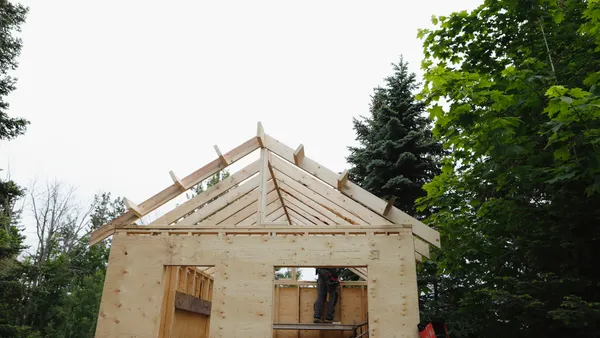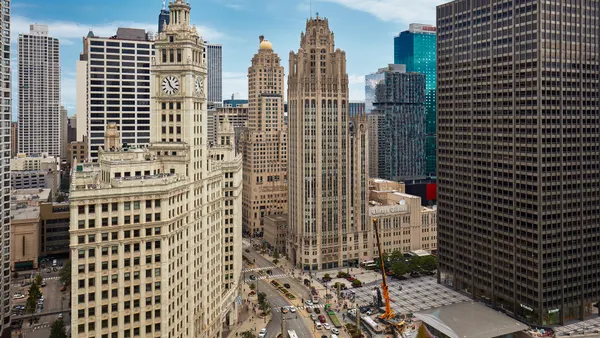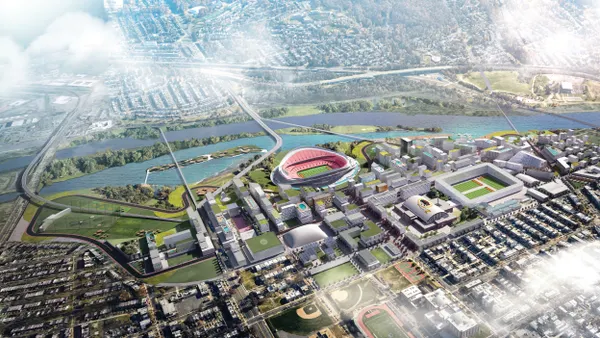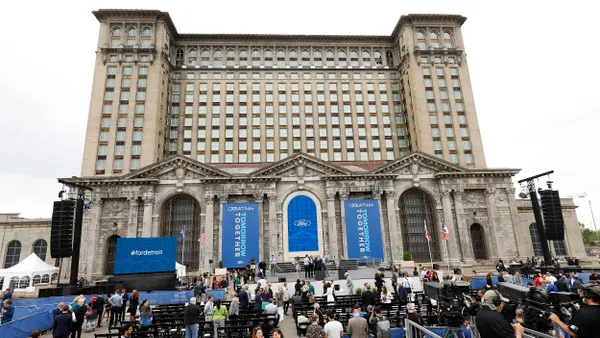Dive Brief:
- The New York City Council approved the “City of Yes for Carbon Neutrality” initiative and an ensuing set of zoning changes to support the city’s goal of slashing carbon emissions 80% below 2005 levels by 2050, according to a Dec. 6 release.
- The initiative, which removes zoning impediments to rooftop solar, solar parking canopies, onshore wind, EV charging and energy storage systems, is the first of three proposals by Mayor Eric Adams to modernize the city’s zoning policies.
- The updates are among the most significant zoning changes in the city’s history, Chief Climate Officer and New York City Department of Environmental Protection Commissioner Rohit Aggarwala said in a statement.
Dive Insight:
The City of Yes for Carbon Neutrality initiative and the 17 policies approved within it took effect on Dec. 11.
The zoning changes allow solar parking canopies up to 15 feet high over all parking areas. These canopies are a straightforward solution to generating more clean energy and have seen widespread adoption elsewhere, but uptake has lagged in New York City in part because of zoning challenges, according to the “City of Yes for Carbon Neutrality” proposal document.
The zoning updates will also enable more rooftop solar citywide by allowing systems on buildings taller than the permitted height in their respective zoning districts, and increasing height allowances on both sloped and flat roofs.
Community solar project planners have in the past struggled to understand if they can serve multiple properties, the proposal document says, and the zoning updates aim to clarify that solar generation is a permitted use citywide and that solar energy systems can serve multiple zoning lots when they are in the same ownership.
To simplify wind turbine development along the city’s waterfront, the updates enable the City Planning Commission to consider proposals for turbines that are taller than current height limits allow. Updates also now include wind energy systems within the broader “energy infrastructure equipment” uses and allow modification of related zoning rules so that systems can be sited along the waterfront.
Decarbonizing existing buildings
Zoning challenges have hindered building owners trying to electrify mechanical equipment or add new energy infrastructure, the proposal document says.
In addition to easing wall height and thickness rules that hinder building electrification and retrofit efforts, the initiative expands buildings’ rooftop and yard allowances to accommodate the increased need for outdoor electrified equipment such as heat pumps. It changes other rules to ensure a wide range of exterior retrofits and updates “Zone Green” floor area exemptions to ensure a better-than-code performance. It updates the framework for accessory mechanical equipment, like HVAC units and fire protection systems, to reflect the needs of electric retrofits and other energy infrastructure, by enabling equipment to cover up to 50% of buildings to a height of 15 feet, the proposal says.
These changes are expected to help facilitate environmentally friendly retrofits for over 50,000 buildings, the release says.
Space for EV charging and micromobility parking
The zoning changes will make more than 400 million extra square feet of space available for EV chargers, according to a news release. All commercial and manufacturing areas will be allowed to have EV charging, and shared charging infrastructure will also be allowed in parking facilities, according to the proposal document. The initiative clarifies that operators can add EV charging to spaces in both accessory and public parking facilities, and makes up to 20% of spaces in accessory facilities available for shared EV charging and car-share use.
The initiative also seeks to encourage the use of bicycles and other micromobility vehicles by creating clear allowances for public bicycle parking.
Building out energy storage
Energy storage systems also received sweeping zoning updates as part of the approval. While energy storage systems were previously considered electricity utility substations, limiting their implementation and size within commercial and manufacturing districts, these systems are now categorized in the broader “energy infrastructure equipment” use case. This means energy storage systems can be used in residential districts on sites up to 10,000 square feet and without size limits in commercial and manufacturing districts.
Some city council members criticized allowing such systems in residential areas. “People don’t deserve to live next-door to a [battery energy storage systems], and they belong in industrial areas, or perhaps certain commercial zones,” said Councilmember Joseph Borelli, according to silive.com. Borelli was one of eight New York City councilmembers who voted no on the proposal.
Water, waste and food
The zoning changes include multiple measures to encourage what the proposal document calls “simple and straightforward solutions” to reduce stormwater runoff, cut down on organic material sent to landfills and boost local food production by making it easier to build rooftop greenhouses.
To reduce stormwater runoff, permeable paving will explicitly be allowed citywide, and new forms of planting such as raingardens and grouped street trees will be allowed in some cases on sidewalks adjacent to new and enlarged developments.
The zoning updates add clear regulations for composting and recycling, which previously were not mentioned at all in zoning policies, according to the proposal document. Composting and recycling facilities will now be allowed in all commercial districts, subject to a 5,000-square-foot size limit.











